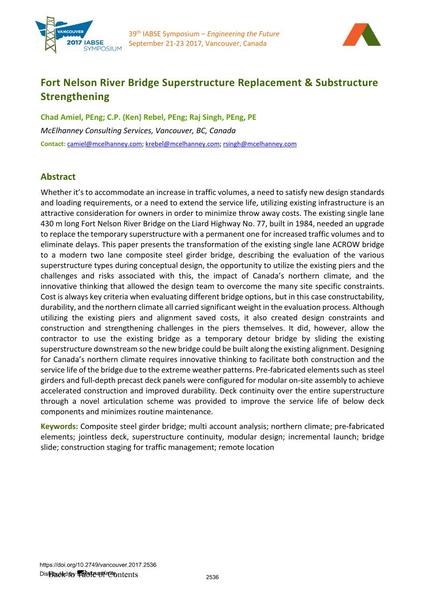Fort Nelson River Bridge Superstructure Replacement & Substructure Strengthening

|
|
|||||||||||
Détails bibliographiques
| Auteur(s): |
Chad Amiel
(McElhanney Consulting Services, Vancouver, BC, Canada)
C. P. Rebel (McElhanney Consulting Services, Vancouver, BC, Canada) Raj Singh (McElhanney Consulting Services, Vancouver, BC, Canada) |
||||
|---|---|---|---|---|---|
| Médium: | papier de conférence | ||||
| Langue(s): | anglais | ||||
| Conférence: | IABSE Symposium: Engineering the Future, Vancouver, Canada, 21-23 September 2017 | ||||
| Publié dans: | IABSE Symposium Vancouver 2017 | ||||
|
|||||
| Page(s): | 2536-2542 | ||||
| Nombre total de pages (du PDF): | 7 | ||||
| Année: | 2017 | ||||
| DOI: | 10.2749/vancouver.2017.2536 | ||||
| Abstrait: |
Whether it’s to accommodate an increase in traffic volumes, a need to satisfy new design standards and loading requirements, or a need to extend the service life, utilizing existing infrastructure is an attractive consideration for owners in order to minimize throw away costs. The existing single lane 430 m long Fort Nelson River Bridge on the Liard Highway No. 77, built in 1984, needed an upgrade to replace the temporary superstructure with a permanent one for increased traffic volumes and to eliminate delays. This paper presents the transformation of the existing single lane ACROW bridge to a modern two lane composite steel girder bridge, describing the evaluation of the various superstructure types during conceptual design, the opportunity to utilize the existing piers and the challenges and risks associated with this, the impact of Canada’s northern climate, and the innovative thinking that allowed the design team to overcome the many site specific constraints. Cost is always key criteria when evaluating different bridge options, but in this case constructability, durability, and the northern climate all carried significant weight in the evaluation process. Although utilizing the existing piers and alignment saved costs, it also created design constraints and construction and strengthening challenges in the piers themselves. It did, however, allow the contractor to use the existing bridge as a temporary detour bridge by sliding the existing superstructure downstream so the new bridge could be built along the existing alignment. Designing for Canada’s northern climate requires innovative thinking to facilitate both construction and the service life of the bridge due to the extreme weather patterns. Pre-fabricated elements such as steel girders and full-depth precast deck panels were configured for modular on-site assembly to achieve accelerated construction and improved durability. Deck continuity over the entire superstructure through a novel articulation scheme was provided to improve the service life of below deck components and minimizes routine maintenance. |
||||
